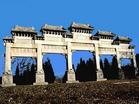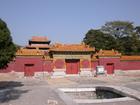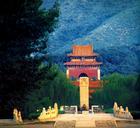CONTACT US
| +86-10-82600771 | |
| WhatsApp: +86-13911460247 | |
| Messenger: chinatournet | |
WeChat ID: callchinatour | |
50 kilometers northwest from Beijing City lies the Ming Tombs - the general name given to the mausoleums of 13 emperors of the Ming Dynasty (1368 - 1644). The mausoleums have been perfectly preserved, as has the necropolis of each of the many emperors. Because of its long history, palatial and integrated architecture, the site has a high cultural and historic value. The layout and arrangement of all thirteen mausoleums are very similar but vary in size as well as in the complexity of their structures.
It was originally built only as Changling, the tomb of Emperor Zhu Di and his empresses. This is the most magnificent of the tombs. The succeeding twelve emperors had their tombs built around Changling.




Only the Changling and Dingling tombs are open to the public. Changling, the chief of the Ming Tombs, is the largest in scale and is completely preserved. The total internal area of the main building is 1956 square meters. There are 32 huge posts, and the largest measures about 14 meters in height.It inhumes Emperor Zhudi, the fourth son of Emperor Zhu Yuanzhang. Travel China Guide recommends the Lingsi Palace in its second yard as really deserving a visit. This is unique as it is the only huge palace made of camphor wood. It covers about 1956 square meters. The ceiling is colorfully painted and supported by sixteen solid camphor posts. The floor was decorated with gold bricks.
Unlike Changling, Dingling is under ground and about 27 meters deep. It is the mausoleum of Emperor Zhu Yijun, the thirteenth emperor who occupied the throne the longest during the Ming Dynasty, and his two empresses. The main features are the Stone Bridge, Soul Tower, Baocheng and the Underground Place, which was unearthed between 1956 and 1958. The entire palace is made of stone. The Soul Tower is symbolic of the whole of Dingling and it forms the entrance to the underground chambers. The yellow glazed tiles; eaves, archway, rafters and columns are all sculptured from stone, and colorfully painted. The entire construction is stable and beautiful!
Served by three stone doors, it is divided into three Halls consisting of five high palaces - the front, the middle, the rear, the left and the right palaces. The Gate of the Tomb, the Gate of Eminent Favor and the Lingxing Gate all have the same structural form.
The front hall, considered the square of the Palace, has no building within it. No special artifacts remain in either the left and right palaces that are about 7 meters high, six meters wide, and 26 meters long. However, each has a centrally placed white marble coffin bed, the surface of which is covered with gold bricks. On each bed there is a square hole filled with loess. This is the so-called "Gold Well". A paved path leads to the central hall where there are three white marble thrones. Incense, candles and flowers were set in front of the thrones. Before each of them, there are glazed 'Five Offerings' and a blue china jar that would have been filled with sesame oil to be used for lamps. The rear hall is the main and biggest part of the Palace. The coffins of Emperor Zhu Yijun and his two empresses are in this palace. There are also some precious items displayed with these coffins; among them is the gold imperial crown, one of the world's most rare treasures.